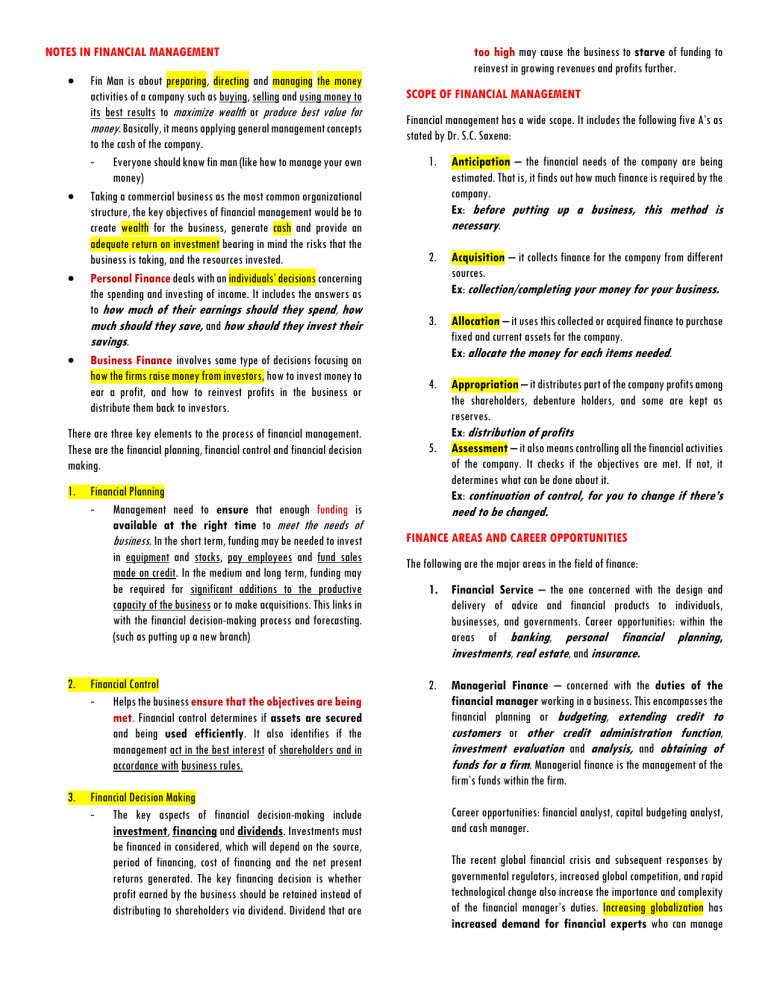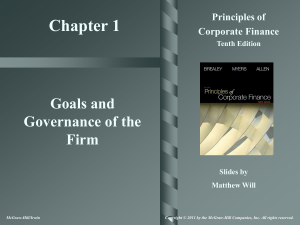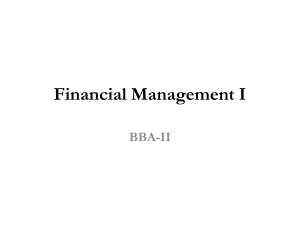
NOTES IN FINANCIAL MANAGEMENT Fin Man is about preparing, directing and managing the money activities of a company such as buying, selling and using money to its best results to maximize wealth or produce best value for money. Basically, it means applying general management concepts to the cash of the company. - Everyone should know fin man (like how to manage your own money) Taking a commercial business as the most common organizational structure, the key objectives of financial management would be to create wealth for the business, generate cash and provide an adequate return on investment bearing in mind the risks that the business is taking, and the resources invested. Personal Finance deals with an individuals’ decisions concerning the spending and investing of income. It includes the answers as to how much of their earnings should they spend, how much should they save, and how should they invest their too high may cause the business to starve of funding to reinvest in growing revenues and profits further. SCOPE OF FINANCIAL MANAGEMENT Financial management has a wide scope. It includes the following five A’s as stated by Dr. S.C. Saxena: 1. Anticipation – the financial needs of the company are being estimated. That is, it finds out how much finance is required by the company. Ex: before putting up a business, this method is necessary. 2. Acquisition – it collects finance for the company from different sources. Ex: collection/completing your money for your business. 3. Business Finance involves same type of decisions focusing on how the firms raise money from investors, how to invest money to ear a profit, and how to reinvest profits in the business or distribute them back to investors. Allocation – it uses this collected or acquired finance to purchase fixed and current assets for the company. Ex: allocate the money for each items needed. 4. There are three key elements to the process of financial management. These are the financial planning, financial control and financial decision making. 5. Appropriation – it distributes part of the company profits among the shareholders, debenture holders, and some are kept as reserves. Ex: distribution of profits Assessment – it also means controlling all the financial activities of the company. It checks if the objectives are met. If not, it determines what can be done about it. Ex: continuation of control, for you to change if there’s savings. 1. Financial Planning - Management need to ensure that enough funding is available at the right time to meet the needs of business. In the short term, funding may be needed to invest in equipment and stocks, pay employees and fund sales made on credit. In the medium and long term, funding may be required for significant additions to the productive capacity of the business or to make acquisitions. This links in with the financial decision-making process and forecasting. (such as putting up a new branch) 2. Financial Control - Helps the business ensure that the objectives are being met. Financial control determines if assets are secured and being used efficiently. It also identifies if the management act in the best interest of shareholders and in accordance with business rules. 3. Financial Decision Making - The key aspects of financial decision-making include investment, financing and dividends. Investments must be financed in considered, which will depend on the source, period of financing, cost of financing and the net present returns generated. The key financing decision is whether profit earned by the business should be retained instead of distributing to shareholders via dividend. Dividend that are need to be changed. FINANCE AREAS AND CAREER OPPORTUNITIES The following are the major areas in the field of finance: 1. Financial Service – the one concerned with the design and delivery of advice and financial products to individuals, businesses, and governments. Career opportunities: within the areas of banking, personal financial planning, investments, real estate, and insurance. 2. Managerial Finance – concerned with the duties of the financial manager working in a business. This encompasses the financial planning or budgeting, extending credit to customers or other credit administration function, investment evaluation and analysis, and obtaining of funds for a firm. Managerial finance is the management of the firm’s funds within the firm. Career opportunities: financial analyst, capital budgeting analyst, and cash manager. The recent global financial crisis and subsequent responses by governmental regulators, increased global competition, and rapid technological change also increase the importance and complexity of the financial manager’s duties. Increasing globalization has increased demand for financial experts who can manage cash flows in different currencies and protect against the risks that naturally arise from international transactions. The following are the professional certifications in finance: 1. 2. 3. 4. 5. Chartered Financial Analyst (CFA) – a graduate-level course of study focused largely on the investments side of finance. This is offered by the CFA institute. Certified Treasury Professional (CTP) – this program requires students to pass a single exam that is focused on the knowledge and skills needed for those working in a corporate treasury department. Certified Financial Planner (CFP) – students should pass a 10hpur exam covering a wide range of topics related to personal financial planning in order to obtain CFP status. American Academy of Financial Management (AAFM) – this administers certification programs for financial professionals in a wide range of fields. Their certifications include the Charter Portfolio Manager, Chartered Asset Manager, Certified Risk Analyst, Certified Cost Accountant, Certified Credit Analyst, and many other programs. Professional Certifications in Accounting – include Certified Public Accountant (CPA), Certified Management Accountant (CMA), Certified Internal Auditor (CIA), and many other programs. There is ease of organization compared to corporation. In partnership there are: LEGAL FORM OF BUSINESS Sole Proprietorship – owned by one person who’s legally responsible for the debts and taxes of the business. - Most common form of business Simple, and the owner has freedom to make all decisions and enjoy all the profit Minimal legal restrictions and government regulation. It can be discontinued with great ease and tax rate is relatively at the minimum. Owner has unlimited liability Owner has limited availability of outside financing. Partnership – owned by two or more people and operate on an agreement called Article of Co-Partnership. - They are legally responsible for the debts and taxes of business. - Partners must agree upon amount each partner will contribute to the business, percentage of ownership of each partner, share of profits of each partner, duties each partner will perform, and the responsibility each partner has for the partnership’s debts. Typical partnership includes those: - Medical and Dental Practices Accounting Architectural and Law firms Corporation – entity created by law. - Have the legal powers of an individual in that it can sue and be sued. - Make and be party to contracts - Acquire property in its own name. - Publicly or privately-owned business entity that separates form its owner and has a legal right to own property and do business in its own name. - Stockholders are not responsible for the debts or taxes of business. - Governed by BOD in case of profit organization or BOT in case of non-profit org. Advantages: Advantages: - Combined talents More available brain power Managerial skill In terms of available financing, it can raise more capital for the firm than a sole proprietorship. Unlimited liability for general partners and limited life for the firm Partnership is dissolved when a partner withdraws or dies, and it is difficult to liquidate or transfer partnership. Two or more heads may be better for the firm. - Limited liability of stockholders and perpetual life. There is ease of transferring ownership, expansion obtaining resources of financing. Relatively bound more government regulations/restrictions and maybe expensive to organize. All forms of business entities are considered separate entities. However, the corporation is the only form of business that is a separate legal entity. FINANCE, ECONOMICS AND ACCOUNTING Economics – study of choice - Social science that deals with individual or collective economic activities such as production, consumption, distribution and transfer of money and wealth. - This is based on the fact that our resources are scarce and need to deliberately and systematically allocated. Finance – study of financial allocation and answers questions like where to put your money and why. - Form of applied economics - Firms operate within the economy and they must be aware of the economic principles, changes in economic activity, and economic policy. - Marginal Cost-Benefit Analysis – primary economic principle that is being used in managerial finance. This principle reminds the decision makers to choose and take actions only when the firm will have a net advantage, which means that the added benefits exceed the added costs. Accounting – accountants generally use the accrual method while in finance, the emphasis is on cash flows. - Accountants recognize revenues at the point of sale and expenses when incurred regardless on when cash will flow into or out of the firm. - Financial manager focuses on the actual inflows and outflows of cash, recognizing revenues when cash is collected and expenses when actually paid. - GOALS OF THE FIRM AND THE ROLE OF THE FINANCE MANAGER Decision rule for managers: Only take actions that are expected to increase the share price. This rule means that whenever the financial manager decides or choose between or among alternatives, after assessing the risks and the returns, only actions that would increase share price shall be accepted. Otherwise, the alternative/s shall be rejected. The goal of a firm, and therefore of all managers, is to maximize shareholders’ wealth. This can be measured by share price. An increasing price per share of common stock relative to the stock market as a whole indicates achievement of this goal. Given the following opportunities, which investment is preferred? Earnings per Share Year Investment A B Year 1 P14.00 6.00 Year 2 P10.00 10.00 Year 3 P4.00 14.00 Total P28.00 30.00 Based on the information provided, the choice is not obvious. Profit maximization is not consistent with wealth maximization. It may not lead to the highest possible share price due to the following reasons: 1. Timing is important. The receipt of funds sooner rather than later is preferred. - Project B is expected to provide the higher overall increase in earnings, thus, is the more profitable project. - But, since the goal of the firm is to maximize value, and therefore, timing must be considered to determine which project is superior. - Profit maximization may lead to value maximization, but it is not an absolute case. 2. Profits do not necessarily result in cash flows available to stockholders. In finance, cash is king. - It is not unusual for a firm to be profitable yet experience a cash crunch. - They might have so much profit but less do not have enough cash to continuously run the business. - The most common cause is when expenses have a shorter due date than expected revenue. In such cases, the firm must arrange short term financing to meet its debt obligations before the revenue arrives. 3. Profit Maximization fails to account for risk. Risk is the chance that actual outcomes may differ from expected outcomes. - Financial managers must consider both risk and return because of their inverse effect on the share price of the firm. - Increased risk may decrease the share price, while increased return is likely to increase the share price. - Financial managers administer the financial affairs of all types of businesses such as private and public, large and small, profit-seeking and notfor-profit. Typically, he handles a firm’s cash, investing surplus funds when available and securing outside financing when needed. He also oversees a firm’s pension plans and manages critical risks related to movements in foreign currency values, interest rates and commodity prices. The treasurer in a mature firm must make decisions with respect to handling financial planning, acquisition of fixed assets, obtaining funds to finance fixed assets, managing working capital needs, managing the pension fund, managing foreign exchange, and distribution of corporate earnings to owners. The two key activities that the financial manager does as related to a firm’s balance sheet are the following. 1. Investment Decisions - The finance manager defines the most efficient level and the best structure of assets. - Investment decisions deals with the items that appear on the asset section of the balance sheet. 2. Financing Decisions - The finance manager determines and maintains the proper combination of short- and long-term financing. - Also, he raises the needed financing in the most economical manner. - Financing decisions generally refers to the items that appear on the liability and equity section of the balance sheet. CORPORATE GOVERNANCE, ETHICS AND AGENCY Corporate Governance - A system of organizational control that defines and establishes the responsibility and accountability of the major participants in an organization. - Shareholders, board of directors, managers and officers of the corporations and other stakeholders are the major participants included here. - More detailed responsibilities would be established within each part of the organizational chart. Business Ethics - Are the standards of conduct or moral judgment that apply to persons engaged in industry or commerce. - Violations of these standards in finance include, but not limited to misstated financial statements, misleading financial forecasts or projections, fraud, bribery, kickbacks, - - - - - - insider trading, excessive executive compensation and options backdating. Bad publicity generally results to negative impacts on a firm. Ethics programs seek to reduce lawsuits and judgment costs, uphold and preserve a positive corporate image, build trust and confidence of the stockholders, and to gain the loyalty and respect of all stakeholders. The expected result of such program is to positively affect the firm’s share price. Shareholders are the owners of a corporation, and they purchase stocks because they want to earn a good return on their investment without undue risk exposure. In most cases, shareholders elect directors, who the hire managers to run the corporation on a day-to-day basis. Because managers are supposed to be working on behalf of shareholders, they should pursue policies that enhance shareholder value. Also, to achieve this goal, the financial manager would take only those actions that were expected to make a major contribution to the firm’s overall profits. When managers deviate from the goal of maximization of shareholder wealth by putting their personal goals above the goals of shareholders, this results to agency problems and issues. This kind of problems increases agency costs. Agency costs are the costs borne by shareholders due to the occurrence and avoidance of agency problems. Both cases represent a reduction in the shareholders’ wealth. The agency problem and the associated agency costs can be reduced with the following: 1. 2. Properly constructed and implemented corporate governance structure. - This should be designed to institute a system of checks and balances to reduce the ability and incentives of management to deviate from the goal of shareholder wealth maximization. Structured expenditures thru compensation plans. - This maybe the most popular way to deal with the agency problem but this is the most expensive one. - It could either be incentive or performance plans. - Incentive plans tie management performance to share price - When the managers take actions that maximize stock, they could be given stock options giving them the right to purchase stock at a set price. - This incentive plan may not be favorable because of market behavior that has a substantial impact on share price and is beyond the control that’s why performance plans are more popular today. In this plan, compensation is based on performance measures, such as earnings per share and/or its growth, or other return ratios. - Managers may receive performance shares and/or cash bonuses when the set performance goals are attained. Market Forces - Such as shareholder crusading from large institutional investors. - Institutional investors hold large quantities of shares in many of the corporations in their portfolio - The power of institutional investors far exceeds the voting power of individual investors - Managers of these institutions should be active in the monitoring of management and vote their shares for the benefit of the shareholders. - This can lessen or avoid the agency problem because these. - It pressures on management to take actions that maximize shareholder wealth. - They may use their voting powers to elect new directors who are aligned with their objectives and will act to replace poorly or non-performing managers. Threat of hostile takeovers - It occurs when a company or group not supported by existing management attempts to acquire the firm. - Because the acquirer looks for companies that are poorly managed and undervalued, this threat provokes managers to act in the best welfares of the firm’s owners. - 3. 4.






